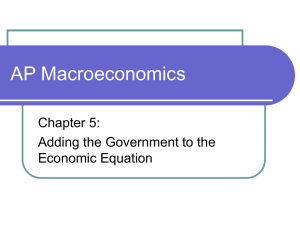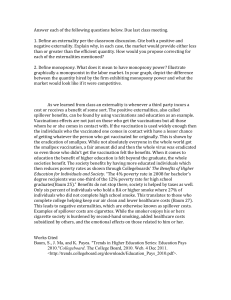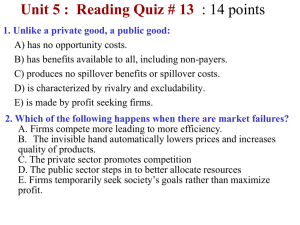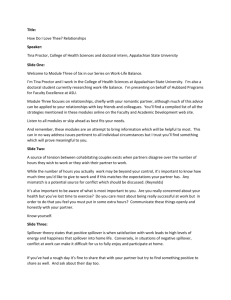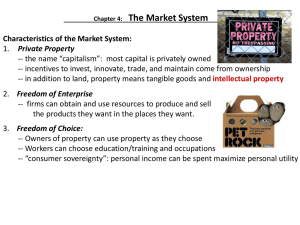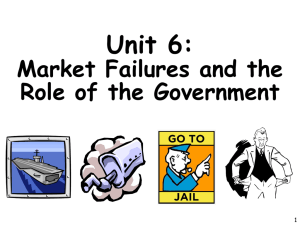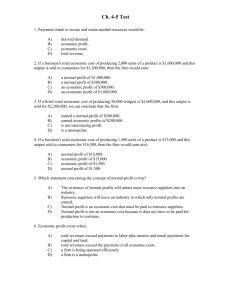Chap030
advertisement
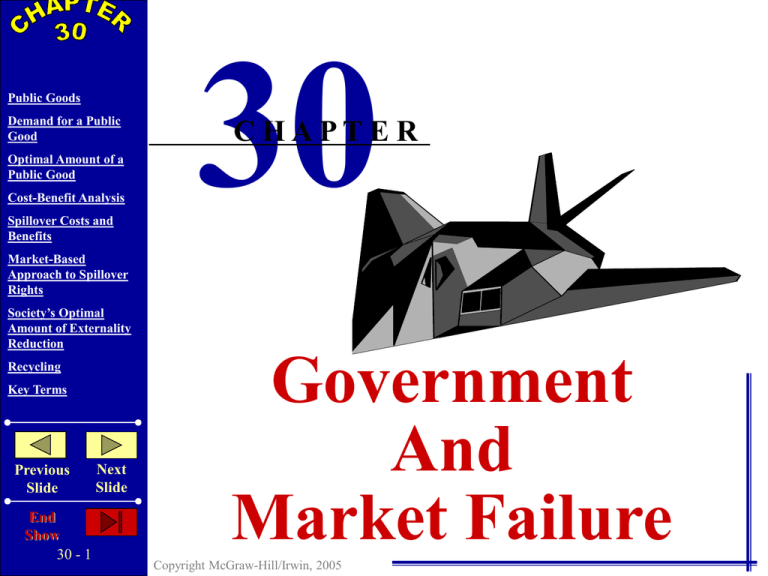
Public Goods Demand for a Public Good Optimal Amount of a Public Good Cost-Benefit Analysis Spillover Costs and Benefits 30 C HAPTE R Market-Based Approach to Spillover Rights Society’s Optimal Amount of Externality Reduction Recycling Key Terms Previous Slide End Show 30 - 1 Next Slide Government And Market Failure Copyright McGraw-Hill/Irwin, 2005 PUBLIC GOODS Public Goods Demand for a Public Good Optimal Amount of a Public Good Cost-Benefit Analysis Spillover Costs and Benefits Market-Based Approach to Spillover Rights Society’s Optimal Amount of Externality Reduction Recycling Rivalry & Excludability (Chapter 5) Private Goods Divisibility Demand Curve is Horizontal Summation Public Goods Key Terms Previous Slide End Show 30 - 2 Next Slide Indivisibility Copyright McGraw-Hill/Irwin, 2005 DEMAND FOR A PUBLIC GOOD Problems of Revealing Preferences Public Goods Demand for a Public Good Optimal Amount of a Public Good Cost-Benefit Analysis Spillover Costs and Benefits Market-Based Approach to Spillover Rights Society’s Optimal Amount of Externality Reduction Recycling Quantity 1 Adams’ Willingness to pay (price) Exclusion Principle does not apply Key Terms Previous Slide End Show 30 - 3 Benson’s Collective Willingness Willingness to pay (price) to pay (price) Next Slide Copyright McGraw-Hill/Irwin, 2005 DEMAND FOR A PUBLIC GOOD Problems of Revealing Preferences Public Goods Demand for a Public Good Optimal Amount of a Public Good Quantity Adams’ Willingness to pay (price) 1 $4 Cost-Benefit Analysis Spillover Costs and Benefits Market-Based Approach to Spillover Rights Society’s Optimal Amount of Externality Reduction Recycling Key Terms Previous Slide End Show 30 - 4 Next Slide Copyright McGraw-Hill/Irwin, 2005 Benson’s Collective Willingness Willingness to pay (price) to pay (price) + $5 = $9 DEMAND FOR A PUBLIC GOOD Problems of Revealing Preferences Public Goods Demand for a Public Good Optimal Amount of a Public Good Quantity Adams’ Willingness to pay (price) 1 2 $4 3 Cost-Benefit Analysis Spillover Costs and Benefits Market-Based Approach to Spillover Rights Society’s Optimal Amount of Externality Reduction Recycling Key Terms Previous Slide End Show 30 - 5 Next Slide Copyright McGraw-Hill/Irwin, 2005 Benson’s Collective Willingness Willingness to pay (price) to pay (price) + $5 + 4 = $9 = 7 DEMAND FOR A PUBLIC GOOD Problems of Revealing Preferences Public Goods Demand for a Public Good Optimal Amount of a Public Good Quantity Adams’ Willingness to pay (price) 1 2 3 $4 3 2 Cost-Benefit Analysis Spillover Costs and Benefits Market-Based Approach to Spillover Rights Society’s Optimal Amount of Externality Reduction Recycling Key Terms Previous Slide End Show 30 - 6 Next Slide Copyright McGraw-Hill/Irwin, 2005 Benson’s Collective Willingness Willingness to pay (price) to pay (price) + $5 + 4 + 3 = $9 = 7 = 5 DEMAND FOR A PUBLIC GOOD Problems of Revealing Preferences Public Goods Demand for a Public Good Optimal Amount of a Public Good Quantity Adams’ Willingness to pay (price) 1 2 3 4 $4 3 2 1 Cost-Benefit Analysis Spillover Costs and Benefits Market-Based Approach to Spillover Rights Society’s Optimal Amount of Externality Reduction Recycling Key Terms Previous Slide End Show 30 - 7 Next Slide Copyright McGraw-Hill/Irwin, 2005 Benson’s Collective Willingness Willingness to pay (price) to pay (price) + $5 + 4 + 3 + 2 = $9 = 7 = 5 = 3 DEMAND FOR A PUBLIC GOOD Problems of Revealing Preferences Public Goods Demand for a Public Good Optimal Amount of a Public Good Quantity Adams’ Willingness to pay (price) 1 2 3 4 5 $4 3 2 1 0 Cost-Benefit Analysis Spillover Costs and Benefits Market-Based Approach to Spillover Rights Society’s Optimal Amount of Externality Reduction Recycling Key Terms Previous Slide End Show 30 - 8 Next Slide Copyright McGraw-Hill/Irwin, 2005 Benson’s Collective Willingness Willingness to pay (price) to pay (price) + $5 + 4 + 3 + 2 + 1 = $9 = 7 = 5 = 3 = 1 OPTIMAL AMOUNT OF A PUBLIC GOOD P Public Goods Demand for a Public Good $9 Optimal Amount of a Public Good Cost-Benefit Analysis Spillover Costs and Benefits Market-Based Approach to Spillover Rights 7 5 Adams’ willingness to pay Society’s Optimal Amount of Externality Reduction 3 Recycling Key Terms Previous Slide End Show 30 - 9 Next Slide 1 D1 0 1 Copyright McGraw-Hill/Irwin, 2005 2 3 4 5 Q OPTIMAL AMOUNT OF A PUBLIC GOOD P Public Goods Demand for a Public Good $9 Optimal Amount of a Public Good Cost-Benefit Analysis Spillover Costs and Benefits Market-Based Approach to Spillover Rights Benson’s willingness to pay 7 5 Society’s Optimal Amount of Externality Reduction 3 Recycling Key Terms Previous Slide End Show 30 - 10 Next Slide D2 D1 1 0 1 Copyright McGraw-Hill/Irwin, 2005 2 3 4 5 Q Public Goods Demand for a Public Good Optimal Amount of a Public Good Cost-Benefit Analysis Spillover Costs and Benefits Market-Based Approach to Spillover Rights OPTIMAL AMOUNT OF A PUBLIC GOOD P When vertically $9 added equals collective 7 willingness to pay 5 Society’s Optimal Amount of Externality Reduction 3 Recycling Key Terms Previous Slide End Show 30 - 11 Next Slide D2 D1 1 0 1 Copyright McGraw-Hill/Irwin, 2005 2 3 4 DC 5 Q OPTIMAL AMOUNT OF A PUBLIC GOOD P Public Goods Demand for a Public Good $9 S Optimal Amount of a Public Good Cost-Benefit Analysis Spillover Costs and Benefits Market-Based Approach to Spillover Rights 7 The public good’s marginal cost as shown by S 5 Society’s Optimal Amount of Externality Reduction 3 Recycling Key Terms Previous Slide End Show 30 - 12 Next Slide DC 1 0 1 Copyright McGraw-Hill/Irwin, 2005 2 3 4 5 Q OPTIMAL AMOUNT OF A PUBLIC GOOD P Public Goods Demand for a Public Good $9 S Optimal Amount of a Public Good Cost-Benefit Analysis Spillover Costs and Benefits Market-Based Approach to Spillover Rights Yields the optimum amount of the public good 7 5 Society’s Optimal Amount of Externality Reduction MB = MC 3 Recycling Key Terms Previous Slide End Show 30 - 13 Next Slide DC 1 0 1 Copyright McGraw-Hill/Irwin, 2005 2 3 4 5 Q COST-BENEFIT ANALYSIS Public Goods Demand for a Public Good Optimal Amount of a Public Good Cost-Benefit Analysis Spillover Costs and Benefits Market-Based Approach to Spillover Rights Society’s Optimal Amount of Externality Reduction Marginal Cost = Marginal Benefit Rule Externalities Spillover Costs Overallocation Recycling Key Terms Previous Slide End Show 30 - 14 Next Slide Spillover Benefits Underallocation Copyright McGraw-Hill/Irwin, 2005 SPILLOVER COSTS AND BENEFITS P Public Goods Demand for a Public Good St Spillover costs Optimal Amount of a Public Good S Cost-Benefit Analysis Spillover Costs and Benefits Market-Based Approach to Spillover Rights Society’s Optimal Amount of Externality Reduction Recycling Key Terms Previous Slide End Show 30 - 15 Overallocation Next Slide 0 Copyright McGraw-Hill/Irwin, 2005 Q0 Qe D Q SPILLOVER COSTS AND BENEFITS P St Public Goods Demand for a Public Good Optimal Amount of a Public Good Spillover Benefits Cost-Benefit Analysis Spillover Costs and Benefits Market-Based Approach to Spillover Rights Society’s Optimal Amount of Externality Reduction Dt Recycling Key Terms Previous Slide End Show 30 - 16 Underallocation Next Slide 0 Copyright McGraw-Hill/Irwin, 2005 Qe Q0 D Q SPILLOVER COSTS AND BENEFITS Public Goods Demand for a Public Good Optimal Amount of a Public Good Cost-Benefit Analysis Spillover Costs and Benefits Market-Based Approach to Spillover Rights Society’s Optimal Amount of Externality Reduction Recycling Key Terms Previous Slide End Show 30 - 17 Next Slide Individual Bargaining – Coase Theorem Liability Rules and Lawsuits Government Intervention Direct Controls Specific Taxes Subsidies and Government Provision Copyright McGraw-Hill/Irwin, 2005 CORRECTING SPILLOVER COSTS P Public Goods Demand for a Public Good St Spillover costs Optimal Amount of a Public Good S Cost-Benefit Analysis Spillover Costs and Benefits Market-Based Approach to Spillover Rights Society’s Optimal Amount of Externality Reduction Recycling Key Terms Previous Slide End Show 30 - 18 TAX Overallocation Corrected Next Slide 0 Copyright McGraw-Hill/Irwin, 2005 Q0 Qe D Q CORRECTING SPILLOVER BENFITS P Public Goods Demand for a Public Good S Optimal Amount of a Public Good Cost-Benefit Analysis Spillover Costs and Benefits Spillover Benefits Market-Based Approach to Spillover Rights Society’s Optimal Amount of Externality Reduction Dt Recycling Key Terms D Underallocation Previous Slide End Show 30 - 19 Next Slide 0 Copyright McGraw-Hill/Irwin, 2005 Qe Q0 Q CORRECTING SPILLOVER BENFITS P Correcting by Subsidy to Consumers Public Goods Demand for a Public Good S Optimal Amount of a Public Good Cost-Benefit Analysis Subsidy to consumer increases demand Spillover Costs and Benefits Market-Based Approach to Spillover Rights Society’s Optimal Amount of Externality Reduction Dt Recycling Key Terms Previous Slide End Show 30 - 20 D Underallocation Corrected Next Slide 0 Copyright McGraw-Hill/Irwin, 2005 Qe Q0 Q CORRECTING SPILLOVER BENFITS Public Goods Demand for a Public Good P Correcting by Subsidy to Producers St Subsidy to producers increases supply Optimal Amount of a Public Good Cost-Benefit Analysis S’t Spillover Costs and Benefits Market-Based Approach to Spillover Rights Society’s Optimal Amount of Externality Reduction Recycling Key Terms Previous Slide End Show 30 - 21 Underallocation Corrected Next Slide 0 Copyright McGraw-Hill/Irwin, 2005 Qe Q0 D Q Demand for a Public Good Optimal Amount of a Public Good Cost-Benefit Analysis Spillover Costs and Benefits Market-Based Approach to Spillover Rights Society’s Optimal Amount of Externality Reduction Recycling Key Terms Previous Slide End Show 30 - 22 Next Slide Price per pollution right Public Goods A MARKET-BASED APPROACH TO SPILLOVER COSTS The Tragedy of the Commons A Market for Externality Rights •Operation of the Market •Advantages S = Supply of pollution rights D 2004 $200 $100 D 2012 500 750 1000 Quantity of pollution rights Copyright McGraw-Hill/Irwin, 2005 SOCIETY’S OPTIMAL AMOUNT OF EXTERNALITY REDUCTION Public Goods Demand for a Public Good Optimal Amount of a Public Good Cost-Benefit Analysis Spillover Costs and Benefits Market-Based Approach to Spillover Rights Society’s Optimal Amount of Externality Reduction Recycling Key Terms Previous Slide End Show 30 - 23 Next Slide Application of MC = MB Rule MC, MB Equilibrium Optimal Reduction of an Externality Shifts in the Curves Graphically… Copyright McGraw-Hill/Irwin, 2005 Public Goods Demand for a Public Good Optimal Amount of a Public Good Cost-Benefit Analysis Spillover Costs and Benefits Market-Based Approach to Spillover Rights Society’s Optimal Amount of Externality Reduction Recycling Key Terms Previous Slide End Show 30 - 24 Next Slide Society’s marginal benefit and marginal cost of pollution abatement SOCIETY’S OPTIMAL AMOUNT OF EXTERNALITY REDUCTION MC Socially optimum amount of pollution abatement MB 0 Q1 Amount of pollution abatement Copyright McGraw-Hill/Irwin, 2005 RECYCLING Public Goods Demand for a Public Good Optimal Amount of a Public Good Cost-Benefit Analysis Spillover Costs and Benefits Market-Based Approach to Spillover Rights Society’s Optimal Amount of Externality Reduction Recycling Key Terms Previous Slide End Show 30 - 25 Next Slide Market for Recyclable Inputs Policy •Demand Incentives •Supply Incentives Global Warming Theory Copyright McGraw-Hill/Irwin, 2005 RECYCLING Public Goods Demand for a Public Good Optimal Amount of a Public Good Cost-Benefit Analysis Spillover Costs and Benefits Market-Based Approach to Spillover Rights Society’s Optimal Amount of Externality Reduction Recycling Key Terms Previous Slide End Show 30 - 26 Next Slide Information Failures Asymmetric Information Inadequate information … about sellers about buyers Moral Hazard Problem Adverse Selection Problem •Workplace Safety Copyright McGraw-Hill/Irwin, 2005 cost-benefit analysis marginal-cost – marginal-benefit rule externalities Coase theorem tragedy of the commons market for externality rights optimal reduction of an externality asymmetric information moral hazard problem adverse selection problem Copyright McGraw-Hill/Irwin, 2005 BACK END Public Goods Demand for a Public Good Optimal Amount of a Public Good Cost-Benefit Analysis Spillover Costs and Benefits Market-Based Approach to Spillover Rights Society’s Optimal Amount of Externality Reduction Recycling Key Terms Previous Slide End Show 30 - 28 Next Slide Public Choice Theory And The Economics of Taxation Chapter 31 Copyright McGraw-Hill/Irwin, 2005
